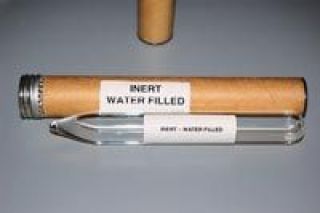TULALIP The U.S. Army Corps of Engineers will begin digging up an old chemical munitions storage site on the Tulalip Indian Reservation next week and should be finished with the $4.5 million project by February of 2007.
Representatives from the Corps of Engineers and the Tulalip Tribes met with the public on Nov. 30 to explain the elaborate precautions being taken at the former Tulalip Backup Ammunition Storage Depot.
The U.S. government used more than 2,000 acres of the reservation during World War II and the Korean War to store chemical weapons and to train personnel in their use. Rail spurs led to a 676-acre storage area near where the Seattle Premium Outlets Mall now sits, and further south the government leased another 1,500 acres for training purposes. After the Korean War, Boeing leased part of the area to destructively test airplane canopies and jet engines. The area used for chemical weapons storage was probably no more than 10 acres in total according to contractors working on the project. They have identified three potential storage pits, and during test digs in June one of them contained a rusted storage drum and soil contaminated with a chemical agent.
We found some interesting things out there, said Rodney Thaie, a project manager with the U.S. Army Corps of Engineers.
Test digs in July found three broken 40 ml glass vials that may have held a 5 percent concentrate liquid mustard gas agent or several other similar derivatives. An air sample triggered a shut down of the site, but those readings were not confirmed, according to a spokesman from the Corps of Engineers. That sparked an expedited schedule to finish the work within six months. Two months were taken to formulate a plan and work should start on Dec. 11.
The site was shut down and Corps engineers fabricated a large sealed tent to contain a dig site measuring six feet by 20 feet long. At most they will be 10 feet deep. Contractors have three such pits they will be working on and showed a complicated venting apparatus used to service a 40 by 80 foot tent placed over the dig site.
Now we are digging inside a building, explained Joe Cudny of the Parsons contracting firm. In this case its a big tank.
He said any contaminated soils will be hauled off the reservation to an approved disposal site where they will be incinerated or placed in a hazardous wasted disposal dump. The soil and the air around the dig will be constantly monitored and the dig will be guarded 24 hours a day.
Cudny estimated that a maximum of 1,500 cubic yards of dirt could be trucked off the grounds.
Planners have met with local police and fire agencies in case an emergency develops, but were certain that their on-site staff could handle anything that transpires. The elaborate safety measures being taken include a variety of safety suits worn by workers and breathing gear for anyone working inside the large tent housing the dig. A small backhoe inside the tent has its own air bottles next to the operators cab, according to pictures shown at meeting at the Quil Ceda Village Conference center. An exclusion zone of a 812-foot radius will be maintained, and there is no threat to any of the retail or gaming operations at Quil Ceda Village, said Bettina Johnson of the Corps of Engineers.
Johnson helps supervise 91 similar sites and said the Tulalip facility is no more unusual than the others.
Interest was sparked when someone mailed a picture to the Washington State governors office in the late 1990s showing a soldier next to a sign warning that chemicals were buried on the reservation.
We are here because of this infamous picture, Cudny said.
Workers from the Corps interviewed people who lived in the area over the last six decades and reviewed aerial photographs that revealed digging scars on the topography of the land.
The site is between 40 and 60 feet above the water table, according to Cudny who said the nearby Quil Ceda Creek is not in danger because the liquid form of the mustard agent binds to the soil and stays put.
In addition to the glass phials, two metal chemical cylinders were found and about four ounces of TNT; the explosive was most likely from logging operations on the reservation.
The Corps of Engineers has a file on hand at the local Marysville Public Library with information about the clean up: visitors wishing to examine the file will have to sign in to examine both the paper and electronic materials. Johnson said they will not be available online due to regulations issued by the Department of Homeland Security; in essence the government doesnt want people to be able to Google the locations of deadly materials.
The Corps also has a hotline for more information: the phone number to call is 256-895-1180.
Corps to press on with Tulalip clean up
TULALIP The U.S. Army Corps of Engineers will begin digging up an old chemical munitions storage site on the Tulalip Indian Reservation next week and should be finished with the $4.5 million project by February of 2007.



